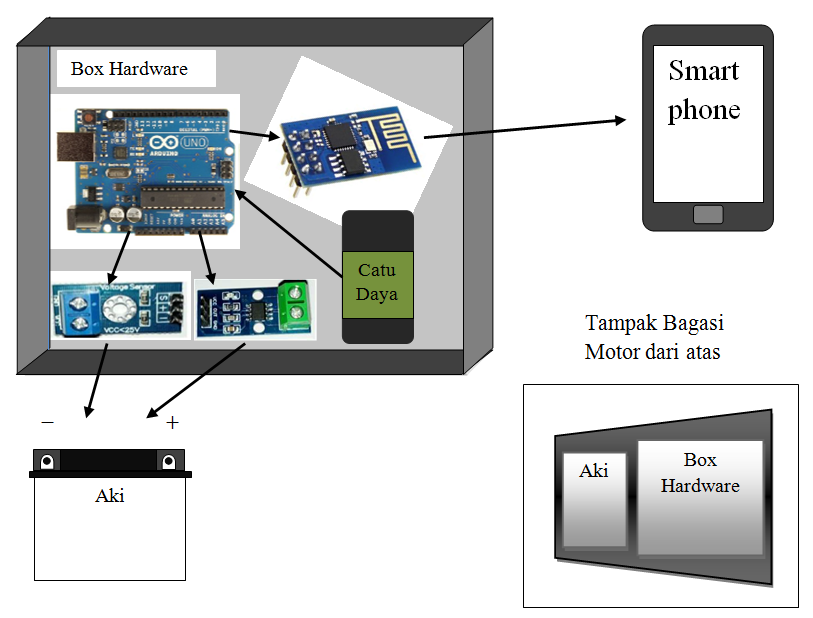Monitoring Tegangan Aki Kendaraan Berbasis Smartphone Android
DOI:
https://doi.org/10.12928/biste.v3i3.4184Keywords:
Tegangan, Aki, Sistem Monitoring, IOT, Arduino, AndroidAbstract
The existence of a battery is very helpful for motorized vehicles to supply electrical power to the electrical components of a motorcycle. As long as the battery is used, sometimes there are problems, namely the ignorance of motorized vehicle users when the battery condition is at a voltage level below the average of 85%, in dry batteries the recommended minimum voltage is 10.5 Volts. This study intends to solve this problem by designing an IoT-based battery current and voltage monitoring system. A tool to monitor the condition of the current and voltage of a motor vehicle battery can be done using the IOT (Internet of Things) monitoring system on an android smartphone. This tool contains components such as Arduino Uno R3 board, voltage sensor, current sensor, ESP8266 wifi module and power supply. The measured data is sent via the internet network, the interface uses an android smartphone and the data is displayed using the ThingView application. The device can monitor battery current and voltage. The battery current and voltage data has been successfully read and sent to the user, the idling data is -0.609 A and 14.82 V, the average rotation data is -0.792 A and 15.042 V, and the high rotation data is -0.861 A and 15.319 V.
Keberadaan aki sangat membantu kendaraan bermotor untuk menyuplai daya listrik menuju komponen listrik sepeda motor. Selama aki digunakan terkadang menemukan masalah yaitu ketidaktahuan pengguna kendaraan bermotor saat kondisi aki telah berada pada level tegangan dibawah rata-rata 85%, pada aki kering tegangan minimal yang disarankan sebesar 10,5 Volt. Penelitian ini bermaksud memecahkan masalah ini dengan mendesain sistem monitoring arus dan tegangan aki berbasis IoT. Alat untuk memantau kondisi arus dan tegangan aki kendaraan bermotor dapat dilakukan menggunakan sistem monitoring IOT (Internet of Things) pada smartphone android. Alat ini mengandung komponen berupa board arduino uno R3, sensor tegangan, sensor arus, modul wifi ESP8266 dan catu daya. Data yang terukur dikirim melalui jaringan internet, antarmuka menggunakan smartphone android dan data ditampilkan menggunakan aplikasi ThingView. Piranti dapat memantau arus dan tegangan aki. Data arus dan tegangan aki berhasil dibaca dan dikirm ke pengguna, data saat langsam sebesar rerata -0,609 A dan 14,82 V, data saat rotasi sedang sebesar rerata -0,792 A dan 15,042 V, serta data saat rotasi tinggi sebesar rerata -0,861 A dan 15,319 V.
References
S. Rochman and B. P. Sembodo, “Rancang Bangun Alat Kontrol Pengisian Aki Untuk Mobil Listrik Menggunakan Energi Sel Surya dengan Metode Sequensial,” Tek. WAKTU, vol. 12, pp. 61–66, 2014. https://doi.org/10.36456/waktu.v12i2.913
I. Setiono, “Akumulator, Pemakaian dan Perawatannya,” METANA, vol. 11, no. 01, pp. 31–36, 2015.
L. Agustian, “Rancang Bangun Sistem Monitoring Kondisi Aki pada Kendaraan Bermotor,” Tek. Elektro Univ. Tanjungpura, vol. 1, 2015.
A. S. Kemederio, A. Muid, and Suhardi, “Prototype Sistem Monitoring Aki Kendaraan Bermotor Menggunakan Arduino Nano dengan Antarmuka Smartphone Android,” Teknol. Inf. dan Komun., vol. 9, pp. 25–36, 2018.
S. Aditomo, I. Sugihartono, and M. A. Hadi, “Rancang Bangun Prototype Sistem Kontrol Dan Monitoring Perangkat Listrik Rumah Tangga Berbasis Aplikasi Mobile Phone dan Komputasi Awan (Cloud Computing),” pp. 243–253, 2017.
Rudi, I. Dinata, and R. Kurniawan, “Rancang Bangun Prototype Sistem Smart Parking,” Ecotipe, vol. 4, no. 2, pp. 14–20, 2017. https://doi.org/10.33019/ecotipe.v4i2.7
S. J. Sokop, D. J. Mamahit, and S. R. U. A. Sompie, “Trainer Periferal Antarmuka Berbasis Mikrokontroler Arduino Uno,” J. Tek. Elektro dan Komput., vol. 5, no. 3, pp. 13–23, 2016.
A. Fitriandi, E. Komalasari, and H. Gusmedi, “Rancang Bangun Alat Monitoring Arus dan Tegangan Berbasis Mikrokontroler dengan SMS Gateway,” ELECTRICIAN, vol. 10, no. 2, pp. 87–98, 2016. https://electrician.unila.ac.id/index.php/ojs/article/view/215
S. Samsugi, Ardiansyah, and D. Kastutara, “Arduino dan Modul Wifi ESP8266 sebagai Media Kendali Jarak Jauh dengan Antarmuka Berbasis Android,” TEKNOINFO, vol. 12, no. 1, pp. 23–27, 2018. https://doi.org/10.33365/jti.v12i1.42
B. Ermanto, “Monitoring Kondisi Tegangan Accu dengan Menggunakan Komunikasi Bluetooth HC-05 dengan Smartphone Android,” Jurnal Teknik Elektro Universitas Tanjungpura, vol. 2, no. 1, 2016. https://jurnal.untan.ac.id/index.php/jteuntan/article/view/17323
Direktorat Marketing R2 Departemen Service R2. 2010. Buku Pedoman Perawatan Suzuki Smash Titan 115. PT Suzuki Indomobil Sales.

Downloads
Published
How to Cite
Issue
Section
License
Copyright (c) 2022 nujkhan tamara, Wahyu Sapto Aji

This work is licensed under a Creative Commons Attribution-ShareAlike 4.0 International License.
Authors who publish with this journal agree to the following terms:
- Authors retain copyright and grant the journal right of first publication with the work simultaneously licensed under a Creative Commons Attribution License that allows others to share the work with an acknowledgment of the work's authorship and initial publication in this journal.
- Authors are able to enter into separate, additional contractual arrangements for the non-exclusive distribution of the journal's published version of the work (e.g., post it to an institutional repository or publish it in a book), with an acknowledgment of its initial publication in this journal.
- Authors are permitted and encouraged to post their work online (e.g., in institutional repositories or on their website) prior to and during the submission process, as it can lead to productive exchanges, as well as earlier and greater citation of published work (See The Effect of Open Access).
This journal is licensed under a Creative Commons Attribution-ShareAlike 4.0 International License.


